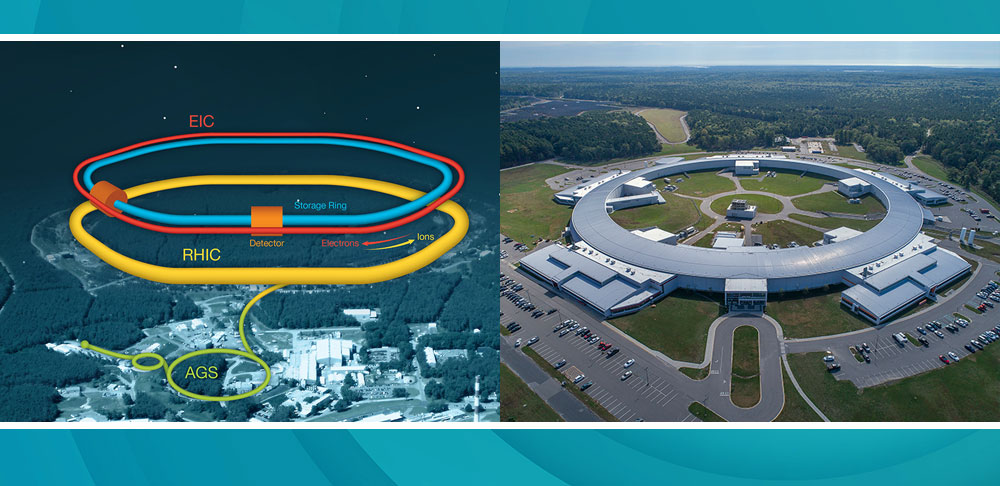Inflation Reduction Act Funding Advances Science at Brookhaven Lab
Infusion of $224 million supports construction of Electron-Ion Collider and new tools for clean energy research at Lab's x-ray light source and nanoscience centers across the DOE complex
November 4, 2022

UPTON, NY— Scientific projects managed by the U.S. Department of Energy’s (DOE) Brookhaven National Laboratory have received an infusion of $224 million (M) in funding as part of the Inflation Reduction Act to support clean energy research, nuclear and high-energy physics programs, and energy-efficiency upgrades. The funding, provided by DOE’s Office of Science, will advance the development of state-of-the-art research tools and support the workforce needed to operate them as the Lab and its partners deliver discovery science and transformative technology to power and secure the nation’s future.
“America’s commitment to science and ingenuity shaped us into the world leaders we are today, and the continued success of our national laboratories will ensure we’re at the global forefront of innovation for generations to come,” said U.S. Secretary of Energy Jennifer M. Granholm. “Thanks to President Biden’s Inflation Reduction Act, these world-class institutions will receive $1.5 billion—one of the largest ever investments in national laboratory infrastructure—to develop advanced energy and manufacturing technologies we need to advance the frontiers of science and tackle tomorrow’s challenges.”
Brookhaven Lab Director Doon Gibbs said, “By supporting research with direct impact on the development of clean energy technologies as well as ground-breaking basic research in nuclear and high-energy physics—fields that could lay the foundation for future advances—this funding is an investment in our nation’s innovation-based economy.”
$105 M will support Brookhaven Lab’s next-generation facility for nuclear physics, the Electron-Ion Collider (EIC). Brookhaven is building the EIC in partnership with DOE’s Thomas Jefferson National Accelerator Facility, which will receive $33 M for work toward the new facility. The EIC will explore how nuclei and nuclear matter emerge from fundamental building blocks known as quarks and gluons and unlock the secrets of the strongest force in nature. This world-leading research and the technological innovations needed to build the EIC have the potential to power the technologies of tomorrow while sparking a wide range of benefits to advance health and medicine, national security, nuclear energy, radioisotope production, and industrial uses of particle beams.
$18.5 M will be used to speed the build out of a suite of three cutting-edge research stations known as beamlines at the National Synchrotron Light Source II (NSLS-II). Collectively called the NEXT-II Project, these beamlines (known as ARI, CDI, and SXN) will make use of NSLS-II’s high-brightness x-ray beams to provide nanometer-scale resolution to map out structural, chemical, electronic, magnetic, and other characteristics of a wide range of materials with potential application in achieving our nation’s clean-energy goals. These include catalysts that drive clean-energy chemical transformations with lower energy requirements; superconductors that transmit electricity with zero energy loss; and next-generation quantum materials.
$20M will support new scientific instrumentation at the five DOE Nanoscale Science Research Centers (NSRCs), which are facilities for characterizing materials at the scale of billionths of a meter and harnessing their unique properties. The Center for Functional Nanomaterials (CFN) at Brookhaven Lab is leading this effort to revitalize the US nanoscience infrastructure by siting 17 new, state-of-the-art instruments at six national laboratories. These funds will accelerate the acquisition, development, and installation of five of these instruments, making them more quickly available for use by scientists from academia and industry. These instruments will be used to advance research on catalysts, fuel cells, solar cells, and other materials that critically underpin the nation’s development of renewable and cleaner forms of energy.
An additional $33 M will support Brookhaven Lab’s ongoing contributions to upgrade the ATLAS detector at the Large Hadron Collider (LHC), located at Europe’s CERN laboratory. These upgrades will enable this state-of-the-art high-energy particle detector to make use of vastly increased particle collision rates expected at the future “high-luminosity” LHC.
The remainder of the funding ($14.5 M) will support infrastructure improvements that will increase efficiencies in the distribution of electricity and heating and air-conditioning systems in scientific laboratory buildings at Brookhaven.
Brookhaven Lab also expects to receive an additional $1 M to develop instrumentation for a nuclear physics experiment searching for “neutrinoless double beta decay” that is being led by DOE’s Lawrence Livermore National Laboratory. Evidence that such a process exists would indicate that subatomic neutrinos serve as their own antiparticles and could offer insight into key properties, including the hierarchy of their masses.
Energy Secretary Granholm and White House officials will be participating in an event this afternoon at DOE’s Argonne National Laboratory to highlight impacts of Inflation Reduction Act funding across the DOE National Laboratory complex. The event will be livestreamed at 2 p.m. Central Time/3 p.m. Eastern Time at energy.gov/live.
Brookhaven National Laboratory is supported by the Office of Science of the U.S. Department of Energy. The Office of Science is the single largest supporter of basic research in the physical sciences in the United States and is working to address some of the most pressing challenges of our time. For more information, visit science.energy.gov.
Follow @BrookhavenLab on Twitter or find us on Facebook.
2022-20923 | INT/EXT | Newsroom









